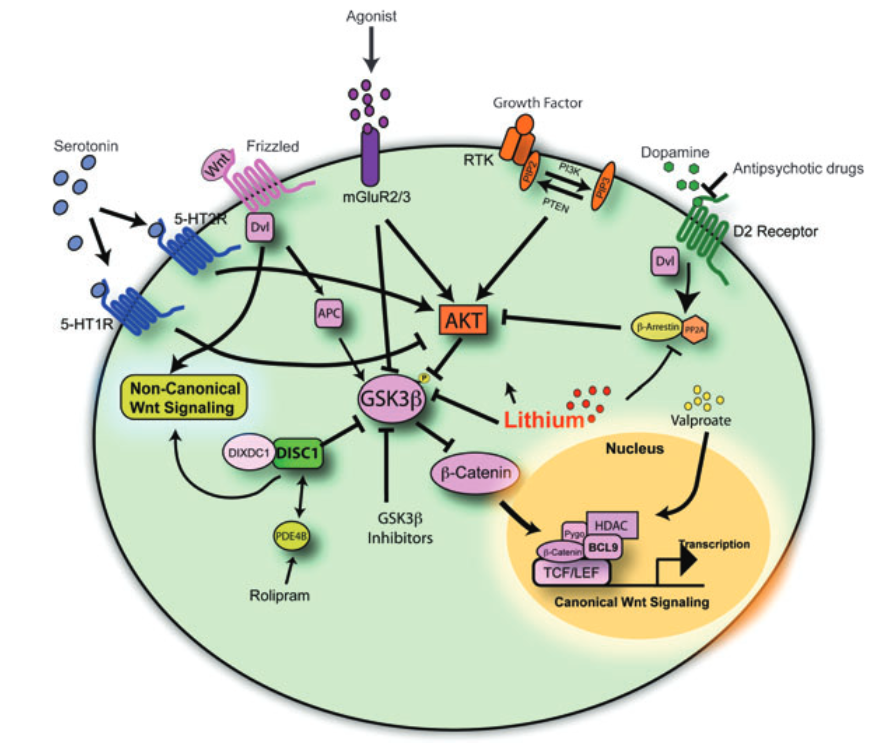
Image from flickr.com
Schizophrenia
Schizophrenia is a neurological condition in which a patient may experience hallucinations, delusions, and other psychotic symptoms. To be diagnosed with Schizophrenia, at least two positive symptoms must be present and last for at least one month (refer to figure 1, find chart with positive symptoms). This disorder is believed to be caused by issues with brain development and neural connectivity (Singh, 2013). Patients tend to display deficits in cognitive functions during early adolescence. This cognitive disruption as well as early environmental issues like infection during pregnancy, cause a child to be at higher risk for developing schizophrenia. These factors lead us to believe that the pathophysiology of Schizophrenia begins in development.
Wnt Signaling
According to (Singh, 2013), there is substantial evidence that issues with the Wnt signaling pathway and its intersection with the dopamine pathway is a potential cause for the disorder. The Wnt pathway involves a Wnt ligand binding to its receptor and then causing a cascade of effects which eventually allow for β-catenin, a transcription factor, to enter the nucleus where it can initiate the transcription of genes that are important for development. Disruptions can happen in which the Wnt ligand is not present and therefore cannot bind. When the Wnt ligand is absent, a complex known as the destruction complex keeps β-catenin phosphorylated and its concentrations are decreased. When the Wnt ligand binds, Disheveled (DVL) is recruited to break down the destruction complex leading to decreased phosphorylation and higher concentrations of β-catenin.

Figure 1 shows different modes of Wnt signaling, canonical Wnt signaling, the Wnt-calcium pathway, and the cell polarity pathway (Singh, 2013).
The dopamine pathway is involved with medications called antipsychotics that are used to treat psychotic symptoms. This pathway is one of the main targets for these drugs. The drugs work by inhibiting dopamine receptors, as shown in Figure 2. Akt is an inhibitor of GSK3β by phosphorylation. When the DA receptors are inhibited, there are higher levels of Akt and lower levels of GSK3β. When there are higher levels of Akt, there are lower levels of GSK3β, and higher levels of β-catenin. The purpose of antipsychotic medications is to inhibit the D2 receptors and regulate Wnt signaling. Another treatment of psychotic symptoms is lithium, which can produce mood-balancing effects. Lithium works by inhibiting GSK3β, which can lead to increased levels of β-catenin.

Figure 2. Human genetics and antipsychotic drug usage can influence the Wnt and DA signaling pathway. (Singh, 2013)
Genetics
A few genes have been observed to be related to the onset of schizophrenia. A balanced translocation mutation in the DISC1 gene can lead to increased levels of GSK3β. Without this mutation the function of DISC1 is to regulate β-catenin by inhibiting GSK3β. Patients with schizophrenia have decreased levels of the Akt1 protein (Singh, 2013). This leads to lower levels of Akt and higher levels of GSK3β. Other genetic variations involving single nucleotide and copy number variants have been observed in schizophrenia patients as well as autism patients. This leads us to believe that dysfunction of the Wnt signaling pathway underlies a number of neuropsychiatric disorders.
Animal models
Animal models have been used to mimic human behaviors as observed in schizophrenia patients. The DVL1 knockout mouse displayed problems with social interactions. Akt1 knockout mice appeared to have behavioral abnormalities similar to schizophrenia in humans. The overexpression of GSK3β as well as the lack of β-catenin in mice caused them to display a neuropsychiatric phenotype. Although the behaviors observed in mice aren’t the same as in humans, these models are still important for research as these genetic knockouts or tests would not be done on human subjects.
Conclusion
Wnt signaling is important for genetic transcription during development, and dysfunctions in this pathway can lead to neurological disorders like schizophrenia. The upregulation of GSK3β and the downregulation of β-catenin due to Wnt signaling dysfunction is a main factor for the onset of schizophrenia because of the effects these molecules have on the transcription of genes that are important during development.
References
Singh, K. (2013). An emerging role for Wnt and GSK3 signaling pathways in schizophrenia. Clinical Genetics, 83(6), 511–517. https://doi.org/10.1111/cge.12111